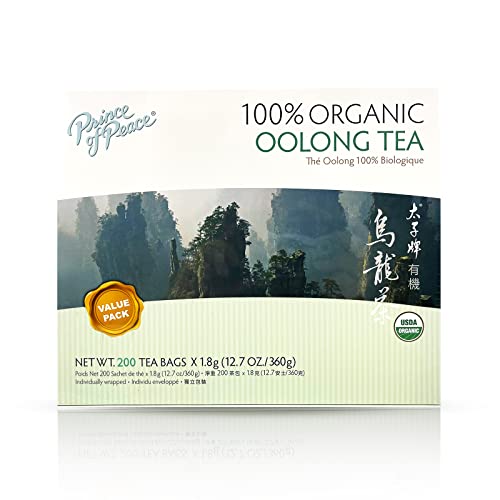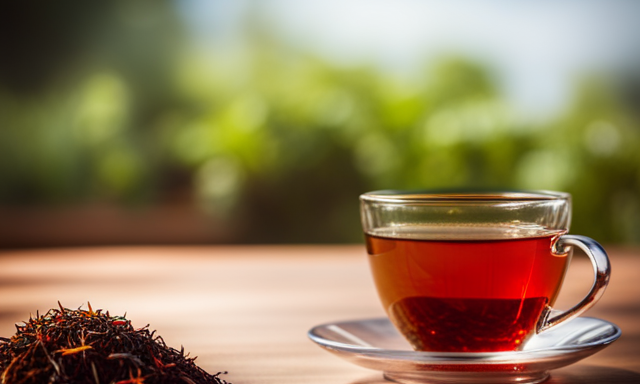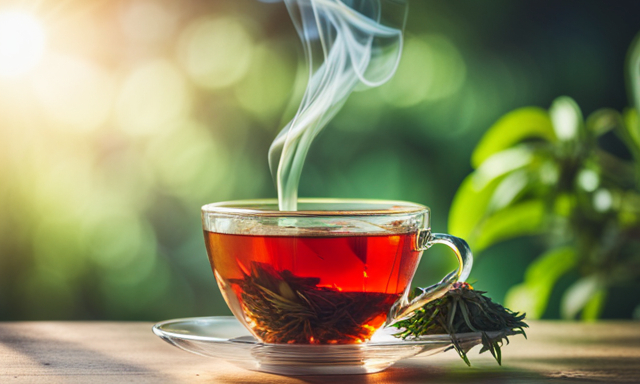Have you ever wanted to sip on a delicious cup of homemade rooibos tea, knowing that you grew the plant yourself? Well, my friend, you’re in luck! In this article, I will guide you through the fascinating journey of growing your very own rooibos tea plant.
Rooibos tea, also known as red bush tea, is a South African herbal beverage that is not only delicious but also packed with health benefits. From reducing inflammation to boosting your immune system, this tea is a true powerhouse.
But how do you get started? Where do you even find rooibos tea seeds or seedlings? Don’t worry, I’ve got you covered. We will explore everything from creating the perfect growing environment to harvesting and processing the leaves.
So, grab your gardening gloves and get ready to embark on this exciting adventure of growing your own rooibos tea plant. Trust me, the satisfaction of brewing and enjoying a cup of tea that you nurtured from seed to sip is truly unparalleled.
Let’s get started!
Key Takeaways
- Obtain high-quality rooibos tea seeds or seedlings from reputable nurseries or online suppliers.
- Provide the rooibos tea plant with full sunlight for at least six hours a day and well-draining soil.
- Transplant carefully to avoid damaging the roots and ensure similar soil and drainage conditions in the new location.
- Regular pruning promotes bushier growth and the harvesting of leaves for tea production.
Understanding the Rooibos Tea Plant
If you’re curious about how to grow the rooibos tea plant, let’s start by understanding the fascinating characteristics of this unique plant.
Rooibos tea, also known as red bush tea, is native to South Africa and is renowned for its numerous health benefits. Understanding rooibos tea benefits is crucial for successful cultivation. Packed with antioxidants, this tea can boost your immune system, improve digestion, and promote healthy skin.
Now, let’s explore rooibos tea flavors. The tea has a naturally sweet taste with hints of nuttiness and caramel. It’s caffeine-free, making it a popular choice for those seeking a calming beverage.
To continue your rooibos tea journey, let’s delve into the next step: obtaining rooibos tea seeds or seedlings.
Obtaining Rooibos Tea Seeds or Seedlings
When I wanted to start growing my own Rooibos tea plants, I had to find a reliable source for Rooibos tea seeds or seedlings.
After doing some research, I discovered that the best place to source Rooibos tea seeds or seedlings is from a reputable nursery or online supplier that specializes in herbal plants.
It’s important to choose healthy and high-quality seeds or seedlings to ensure successful growth and a thriving Rooibos tea plantation.
Where to Source Rooibos Tea Seeds or Seedlings
To find rooibos tea seeds or seedlings, you should start by visiting local nurseries or garden centers, as they may have them available for purchase. Additionally, you can search for rooibos tea seed suppliers online, who specialize in providing a wide variety of seeds and seedlings.
When it comes to planting rooibos tea, it’s crucial to consider the best time to ensure successful growth. Rooibos tea is typically planted during the early spring or fall when the temperatures are mild and the soil is moist. This allows the plant to establish strong roots before facing extreme weather conditions.
Once you have obtained the seeds or seedlings, it’s important to choose healthy and high-quality ones to ensure optimal growth.
Now, let’s move on to the next section about choosing healthy and high-quality seeds or seedlings.
Choosing Healthy and High-Quality Seeds or Seedlings
When selecting seeds or seedlings for your rooibos tea cultivation, it’s essential to choose healthy and high-quality ones. Studies have shown that using superior quality seeds can increase the overall yield of the crop by up to 20%.
To ensure you are getting the best seeds or seedlings for your rooibos tea plant, consider sourcing organic seeds from reputable suppliers. Organic seeds are not only free from harmful chemicals but also promote sustainability in agriculture.
Additionally, you can find local nurseries that specialize in tea plants, as they’re likely to provide high-quality and well-cared-for seedlings. Visiting these nurseries allows you to personally inspect the plants and choose the healthiest ones.
By sourcing organic seeds and visiting local nurseries, you can ensure the success of your rooibos tea cultivation.
Now, let’s move on to creating the ideal growing environment for your plants.
Creating the Ideal Growing Environment
When it comes to selecting the right location for my Rooibos tea plant, I need to consider a few key factors.
First and foremost, the plant requires full sunlight for at least six hours a day, so I need to find a spot in my garden that receives adequate sunlight.
Additionally, the plant prefers well-draining soil, so I will need to ensure the soil in that area is loose and sandy, allowing for proper drainage.
Selecting the Right Location for Your Rooibos Tea Plant
Choosing the perfect location for your rooibos tea plant can significantly impact its growth and yield, ultimately leading to a more satisfying tea-drinking experience. Did you know that a well-chosen location can increase the flavor intensity of the tea leaves by up to 30%? When selecting the right spot for your plant, it is crucial to consider two key factors: optimal sunlight and proper temperature maintenance. Rooibos tea plants thrive in full sun, so choose a location that receives at least six hours of direct sunlight per day. Additionally, ensure that the temperature remains between 60°F and 85°F (15°C and 29°C) throughout the year. To help you in the decision-making process, refer to the table below for a quick overview of the ideal growing conditions for rooibos tea plants:
| Sunlight | Temperature |
|---|---|
| Full sun | 60°F-85°F |
| Moderate shade | Below 60°F or above 85°F |
| Partial shade | Below 60°F-85°F |
Providing the proper soil and drainage conditions is another crucial step in nurturing a thriving rooibos tea plant.
Providing the Proper Soil and Drainage Conditions
To create the perfect environment for your tea leaves to flourish, make sure you provide the right soil and drainage conditions. Here are some key factors to consider:
-
Soil composition: Rooibos tea plants thrive in well-drained soil with a pH level between 4.5 and 6.5. A sandy loam soil is ideal, as it allows for proper root development and water penetration. Avoid heavy clay soils, as they can lead to poor drainage and root rot.
-
Drainage techniques: Good drainage is crucial for the health of your rooibos tea plant. Consider incorporating organic matter, such as compost or peat moss, into the soil to improve drainage. Raised beds or containers can also help ensure proper drainage.
-
Mulching: Apply a layer of organic mulch around the base of the plant to help retain moisture and regulate soil temperature. This will also aid in weed suppression and prevent erosion.
-
Watering: Rooibos tea plants require regular watering, but overwatering can be detrimental. Allow the top layer of soil to slightly dry out before watering again.
-
Transplanting: When transplanting rooibos tea plants, be gentle to avoid damaging the roots. Ensure the new location has the same soil and drainage conditions as the original spot.
With the right soil composition and proper drainage techniques, your rooibos tea plant will have the best chance of thriving. Now, let’s move on to the next section about planting and transplanting rooibos tea.
Planting and Transplanting Rooibos Tea
Once you’ve selected a sunny location, you can start planting and transplanting your rooibos tea plant, as it has an impressive 50% survival rate. When transplanting, it’s important to carefully dig up the plant, making sure to keep the root ball intact. Gently place the plant in a hole that’s slightly larger than the root ball and backfill with a mixture of compost and well-draining soil. Firmly press down the soil around the plant to eliminate any air pockets.
After transplanting, provide adequate water to help the roots establish themselves in their new location. Caring for mature rooibos tea plants involves regular pruning to promote bushier growth and harvesting of the leaves for tea production. With proper transplanting techniques and care, your rooibos tea plant will thrive.
Moving on to watering and fertilizing your rooibos tea plant, it’s important to provide the right amount of moisture and nutrients to ensure its healthy growth.
Watering and Fertilizing Your Rooibos Tea Plant
When it comes to watering my Rooibos tea plant, I make sure to use proper techniques and follow a regular schedule. This entails watering the plant deeply and evenly, allowing the soil to dry out slightly between waterings.
As for fertilization, I employ appropriate methods and adhere to a specific schedule to ensure the plant receives the necessary nutrients for optimal growth. This includes using a balanced organic fertilizer and applying it every two to three months during the growing season.
Proper Watering Techniques and Frequency
Make sure you’re giving your rooibos tea plant enough water, but be careful not to overwater it, as this can lead to root rot. Follow these watering techniques and frequency to ensure the health of your plant:
-
Water deeply: Give your rooibos tea plant a thorough watering, making sure the water reaches the roots. This helps promote strong root growth.
-
Monitor soil moisture: Check the soil moisture regularly by sticking your finger about an inch into the soil. If it feels dry, it’s time to water.
-
Watering frequency: Water your rooibos tea plant every 3-4 days during the growing season. Adjust the frequency based on weather conditions and the plant’s needs.
-
Avoid waterlogged soil: Ensure proper drainage to prevent water from sitting around the roots. This can be achieved by using well-draining soil and pots with drainage holes.
Proper watering techniques and frequency are crucial for the successful growth of your rooibos tea plant. Now, let’s discuss appropriate fertilization methods and schedule.
Appropriate Fertilization Methods and Schedule
After mastering the art of proper watering techniques and frequency for my rooibos tea plants, it was time to delve into the world of fertilization. Fertilizing my plants is essential to ensure they receive the necessary nutrients for healthy growth and abundant harvests.
When it comes to fertilizer application, I prefer using organic alternatives to minimize the use of synthetic chemicals. Organic fertilizers, such as compost or well-rotted manure, provide a slow release of nutrients, promoting long-term soil health. I apply a generous layer of organic fertilizer around the base of each plant, being careful not to let it touch the stem directly.
As for the schedule, I fertilize my rooibos tea plants every four to six weeks during the growing season. With the proper fertilization methods in place, my plants are now ready for the next step: pruning and harvesting rooibos tea.
Pruning and Harvesting Rooibos Tea
To maximize the yield of your rooibos tea plant, carefully trim back the branches, like a skilled hairstylist shaping a client’s hair. Pruning techniques for rooibos tea plants are essential for promoting healthy growth and ensuring optimal harvest.
Here are three key pruning techniques to consider:
-
Selective Pruning: Remove old, diseased, or damaged branches to encourage new growth and prevent the spread of diseases.
-
Tip Pruning: Regularly trim the tips of the branches to stimulate lateral bud development and increase the number of harvestable shoots.
-
Crown Pruning: Trim the crown of the plant to maintain its shape and improve air circulation, reducing the risk of fungal infections.
Knowing the optimal harvesting time is crucial for obtaining the best flavor and aroma from your rooibos tea leaves. Harvest the leaves when they’re young and tender, usually around 18 to 24 months after planting. This ensures that the leaves have reached their peak flavor and nutritional content.
Moving on to drying and processing rooibos leaves, it’s important to…
Drying and Processing Rooibos Leaves
When it comes to drying rooibos leaves, there are various methods that can be employed. One common method is air drying, where the leaves are spread out in a well-ventilated area and left to dry naturally.
Another method is sun drying, where the leaves are laid out in the sun to dry.
In addition to drying, there are also additional processing steps involved in rooibos tea production, such as cutting and sifting the leaves, and then roasting them to enhance the flavor and aroma.
Different Methods of Drying Rooibos Leaves
First, let me show you the various ways you can dry the leaves of your rooibos tea plant for a rich and flavorful brew. When it comes to drying methods, there are a few options you can choose from to preserve the freshness of the leaves. One method is air drying, where you simply spread the leaves out in a well-ventilated area and let them dry naturally. Another method is sun drying, which involves placing the leaves in direct sunlight until they become crisp. Lastly, there is machine drying, where specialized equipment is used to dry the leaves quickly and efficiently. Each method has its own advantages and it’s up to you to decide which one works best for you. Now that we’ve covered the different drying methods, let’s move on to the additional processing steps for rooibos tea production, which will further enhance the flavor and quality of your brew.
Additional Processing Steps for Rooibos Tea Production
Now let’s dive into the next exciting steps that take your rooibos leaves on a transformative journey, unlocking their full potential and creating a tea that will tantalize your taste buds like never before.
After the drying process, additional processing techniques are employed to enhance the flavor and aroma of rooibos tea. These techniques include fermentation and oxidation. During fermentation, the leaves are moistened and exposed to oxygen, allowing natural chemical reactions to occur. This step helps to develop the unique taste and deep red color of rooibos tea.
Oxidation, on the other hand, involves exposing the leaves to air for a specific period of time, which further enhances the flavor profile. These processing techniques not only improve the taste of rooibos tea but also contribute to its numerous health benefits.
Now, let’s move on to the next section about storing and enjoying your homemade rooibos tea, where we’ll learn how to preserve its freshness and savor its delightful flavors.
Storing and Enjoying Your Homemade Rooibos Tea
To fully savor the delightful flavors of your homemade rooibos tea, store it in an airtight container and relish each sip whenever you crave a soothing and refreshing beverage. Storing your tea properly is crucial to maintain its freshness and potency.
Make sure to keep the container away from direct sunlight, moisture, and strong odors to prevent any flavor degradation. Homemade rooibos tea recipes offer a wide range of possibilities, allowing you to experiment with different flavors and ingredients.
Along with its exquisite taste, rooibos tea also offers numerous health benefits, such as its rich antioxidants and potential immune-boosting properties. By incorporating this tea into your daily routine, you can enjoy a delicious and healthy beverage.
Now, let’s delve into troubleshooting common rooibos tea plant issues and ensure your tea garden thrives.
Troubleshooting Common Rooibos Tea Plant Issues
When it comes to growing rooibos tea plants, there are common issues that may arise, such as pest infestations, diseases, or nutritional deficiencies. Identifying and treating pest infestations is crucial to ensure the health and productivity of the plants.
Additionally, addressing any disease or nutritional deficiencies promptly is essential to maintain the quality and yield of the rooibos tea leaves.
Identifying and Treating Pest Infestations
Despite their small size, pests can wreak havoc on a rooibos tea plant, causing damage that must be promptly addressed in order to ensure a healthy growth. Here are four essential steps to identify and treat pest infestations:
-
Treating Aphid Infestations: Aphids are common pests that can weaken rooibos tea plants by sucking sap from leaves and stems. To control aphids, use insecticidal soap or neem oil and spray the affected areas. Pruning heavily infested parts can also help.
-
Preventing Spider Mite Infestations: Spider mites are tiny pests that feed on plant sap, leading to yellowing and curling of leaves. To prevent infestations, regularly inspect plants for spider mites and use a strong jet of water to dislodge them. Applying a horticultural oil spray can also be effective.
-
Monitoring and Early Detection: Regularly inspect the plants for signs of pest infestations. Look for curled leaves, discolored spots, webbing, or tiny insects. Early detection allows for prompt treatment and prevents further damage.
-
Natural Predators: Encourage the presence of beneficial insects like ladybugs, lacewings, or predatory mites. They can help control pest populations naturally, reducing the need for chemical treatments.
By addressing pest infestations promptly, we can ensure the health and vitality of our rooibos tea plants. Now, let’s move on to addressing disease or nutritional deficiencies.
Addressing Disease or Nutritional Deficiencies
Now, let’s explore how you can effectively address any issues related to disease or nutritional deficiencies in your beloved rooibos tea plants.
When it comes to maintaining the health of your plants, nutritional supplements and natural remedies can play a crucial role. Nutritional deficiencies can manifest in various ways, such as stunted growth or discoloration of leaves. To address these issues, consider using organic fertilizers rich in essential nutrients like nitrogen, phosphorus, and potassium. Additionally, you can apply compost or well-rotted manure to enhance soil fertility.
When it comes to diseases, prevention is key. Regularly inspect your plants for any signs of infection and promptly remove and destroy affected parts. Some common diseases in rooibos tea plants include root rot and leaf spot. If necessary, consult a local horticulturist for specific advice on disease management.
By taking proactive measures to address disease and nutritional deficiencies, you can ensure the continued vitality of your rooibos tea plants.
In the next section, we will delve into sharing your rooibos tea plant journey.
Sharing Your Rooibos Tea Plant Journey
When it comes to growing a rooibos tea plant, connecting with other enthusiasts can be an invaluable resource. By sharing tips, experiences, and recipes, we can learn from one another and improve our own cultivation practices.
Joining online forums or attending local tea events are great ways to connect with like-minded individuals and foster a sense of community around our shared passion for rooibos tea.
Connecting with Other Rooibos Tea Enthusiasts
Connecting with other rooibos tea enthusiasts is a great way to share tips, recipes, and experiences while growing this unique plant. By connecting with fellow tea enthusiasts, you can explore different rooibos tea flavors and learn from their experiences.
There are various online communities and forums dedicated to rooibos tea, where you can find like-minded individuals who share your passion. These platforms provide a space to discuss cultivation techniques, harvesting methods, and even the best time to prune your rooibos tea plant.
Through these interactions, you can gain valuable insights and knowledge that will help you in your own tea-growing journey. Sharing tips, experiences, and recipes with others who are equally passionate about rooibos tea can enhance your own understanding and enjoyment of this remarkable plant.
So, let’s dive into the next section and continue our journey of discovering the wonders of growing rooibos tea.
Sharing Tips, Experiences, and Recipes
Discover the joy of exchanging tips, experiences, and recipes with fellow enthusiasts, as you delve deeper into the world of rooibos tea and expand your knowledge. One of the great things about connecting with other rooibos tea lovers is the opportunity to share and learn from each other. Whether it’s discussing the health benefits of rooibos tea or experimenting with different brewing methods, there’s always something new to discover.
In terms of health benefits, rooibos tea is known for its antioxidant properties and its ability to support a healthy immune system. It is also caffeine-free, making it a great alternative to traditional tea or coffee. When it comes to brewing methods, there are various ways to prepare a delicious cup of rooibos tea. Some prefer steeping it in hot water for a few minutes, while others enjoy a longer infusion for a stronger flavor. Adding a slice of lemon or a dash of honey can enhance the taste even further.
So, join the conversation, share your experiences, and learn from others as you explore the world of rooibos tea. Cheers to discovering new flavors and embracing the health benefits it offers!
| Health Benefits | Brewing Methods | Recipes |
|---|---|---|
| – Antioxidant properties |
- Supports a healthy immune system
- Caffeine-free | – Steep in hot water for a few minutes
- Longer infusion for a stronger flavor | – Rooibos iced tea
- Rooibos chai latte
- Rooibos-infused desserts |
Frequently Asked Questions
Can I grow rooibos tea plant indoors?
You can definitely grow a rooibos tea plant indoors! Indoor gardening is a great option for those who want to enjoy alternative tea options. Let me explain the steps to successfully grow this plant indoors.
How long does it take for rooibos tea plant to grow from seed to harvest?
From seed to harvest, a rooibos tea plant takes about 2-3 years. It undergoes several growth stages, including germination, seedling establishment, vegetative growth, and flowering. Adequate sunlight, well-drained soil, and regular watering are essential for optimal growth.
What are some common pests and diseases that affect rooibos tea plants?
Common pests and diseases that affect rooibos tea plants include red spider mites, aphids, and root rot. It is important to regularly monitor the plants for these issues and take appropriate measures to prevent or treat them.
Can I propagate rooibos tea plant from cuttings?
Yes, you can propagate rooibos tea plants from cuttings. It’s like watching a phoenix rise from the ashes – a new plant growing from a small cutting, bringing the benefits of rooibos tea to more people.
Is it possible to grow rooibos tea plant in a container?
Yes, it is possible to grow a rooibos tea plant in a container. Container gardening offers benefits such as flexibility and space optimization. The best soil for container gardening includes a well-draining mixture of compost, sand, and peat moss.
Conclusion
In conclusion, growing a Rooibos tea plant has been a fascinating journey for me.
From understanding the plant’s unique characteristics to creating the perfect growing environment, every step has been filled with excitement.
Just like nurturing a Rooibos plant requires patience and care, our own lives need the same attention to thrive.
By embarking on this journey, we learn that growth isn’t only possible but also rewarding.
So let’s continue to cultivate our passions and watch them bloom into something truly extraordinary.










